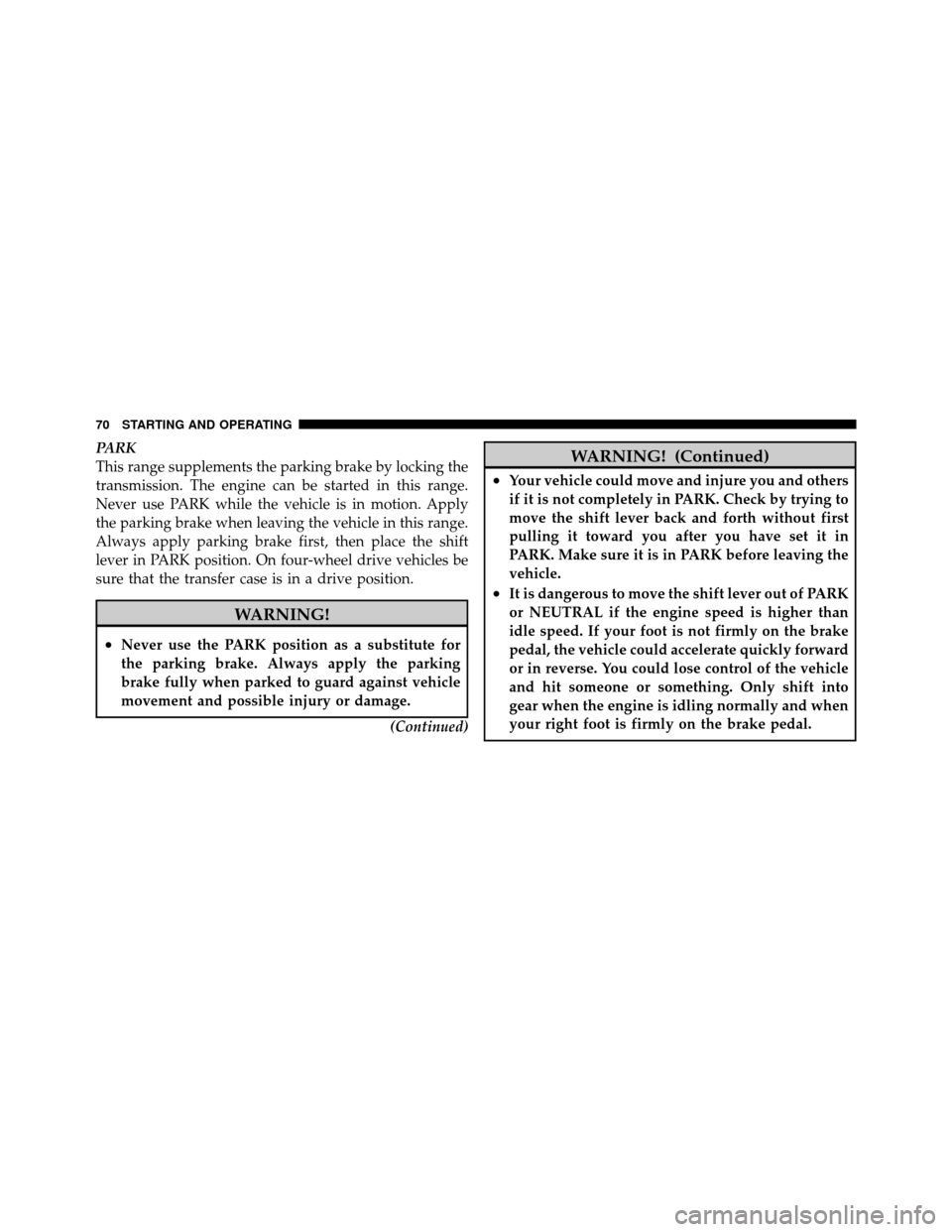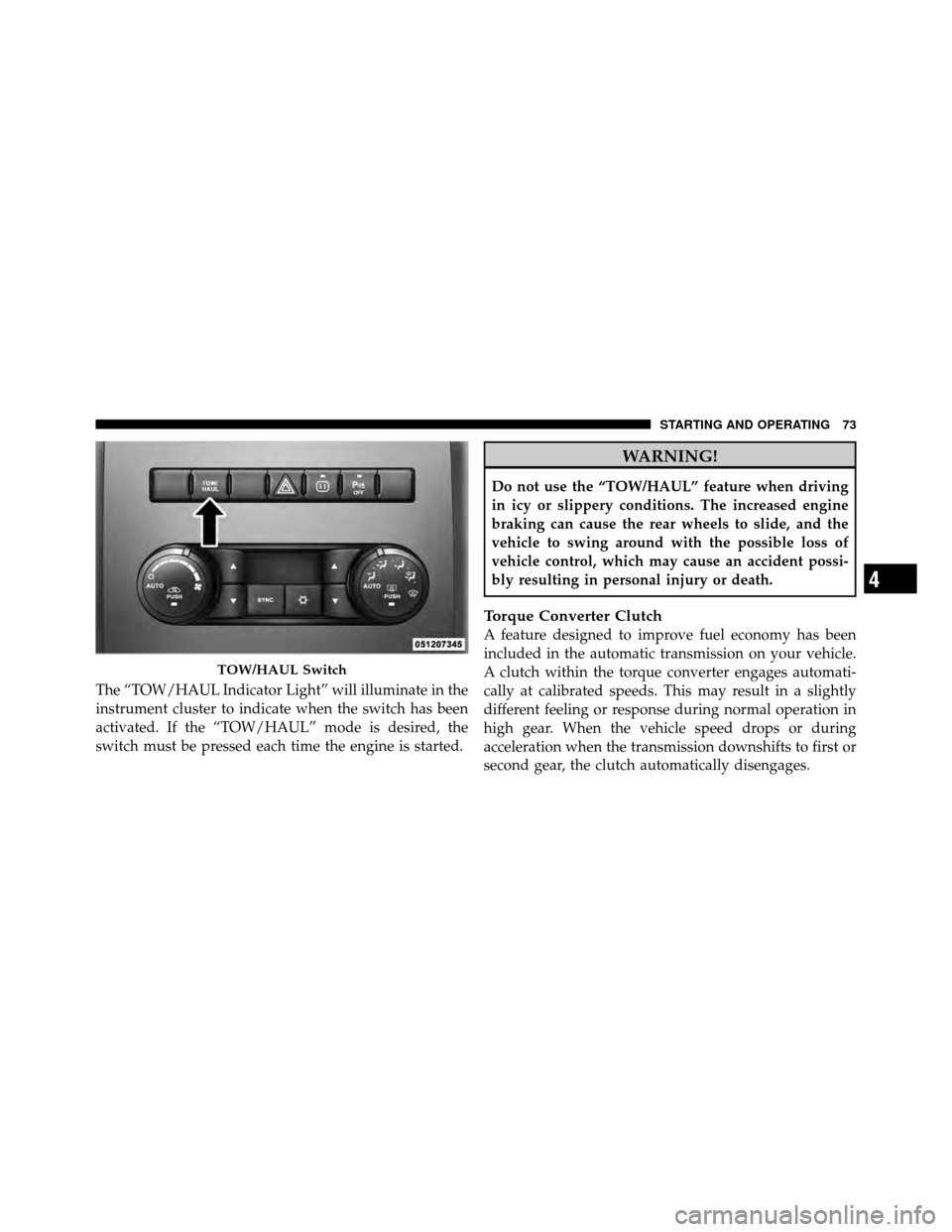Page 71 of 170

PARK
This range supplements the parking brake by locking the
transmission. The engine can be started in this range.
Never use PARK while the vehicle is in motion. Apply
the parking brake when leaving the vehicle in this range.
Always apply parking brake first, then place the shift
lever in PARK position. On four-wheel drive vehicles be
sure that the transfer case is in a drive position.
WARNING!
•Never use the PARK position as a substitute for
the parking brake. Always apply the parking
brake fully when parked to guard against vehicle
movement and possible injury or damage.(Continued)
WARNING! (Continued)
•Your vehicle could move and injure you and others
if it is not completely in PARK. Check by trying to
move the shift lever back and forth without first
pulling it toward you after you have set it in
PARK. Make sure it is in PARK before leaving the
vehicle.
•It is dangerous to move the shift lever out of PARK
or NEUTRAL if the engine speed is higher than
idle speed. If your foot is not firmly on the brake
pedal, the vehicle could accelerate quickly forward
or in reverse. You could lose control of the vehicle
and hit someone or something. Only shift into
gear when the engine is idling normally and when
your right foot is firmly on the brake pedal.
70 STARTING AND OPERATING
Page 72 of 170

REVERSE
This range should be used only after the vehicle has come
to a complete stop.
NEUTRAL
Use this range when the vehicle is standing for prolonged
periods with the engine running. The engine may be
started in this range. Set the parking brake if you must
leave the vehicle.
DRIVE
This range provides all forward gears, including fourth
gear direct, fifth and sixth. Use this range for most city
and highway driving. Upshifts into both overdrive gears,
fifth and sixth, will be delayed when the transmission
fluid temperature is between -4°F (-20°C) and 41°F (5°C).
During very cold conditions when the transmission fluid
is below -4°F (-20°C), the transmission will be limited to
third gear. Normal operation will return after the trans-
mission fluid warms up.NOTE:
Use caution when operating a heavily loaded
vehicle in second or first gear selections in high ambients
as torque converter slip can impose significant additional
heat load on the cooling system.
Overdrive Operation
The Overdrive automatic transmission contains an elec-
tronically controlled fifth and sixth gear. The transmis-
sion will automatically shift from DRIVE to fifth or sixth
gear if the following conditions are present:
•the shift lever is in DRIVE;
•the engine coolant has reached normal operating tem-
perature;
•vehicle speed is above approximately 38 mph
(61 km/h) for fifth gear and 50 mph (80 km/h) for
sixth gear;
•the “TOW/HAUL” switch has not been activated
(sixth gear is inhibited in “TOW/HAUL” mode);
4
STARTING AND OPERATING 71
Page 73 of 170

•transmission has reached normal operating
temperature.
NOTE: If the vehicle is started in extremely cold tem-
peratures, the transmission shift schedule initially re-
stricts transmission operation in forward gear ranges to
third gear until the transmission fluid temperature rises
to a suitable level. During this condition, the ability of the
vehicle to accelerate under heavily loaded conditions
may be reduced. Refer to the “Note” under “Torque
Converter Clutch” in this section.
If the transmission temperature gets extremely hot, the
transmission will automatically select the most desirable
gear for operation at this temperature. If the transmission
temperature becomes hot enough, the “Transmission
Temperature Warning Light” may illuminate. After cool
down, the transmission will resume normal operation. The transmission will downshift from Overdrive to Drive
if the accelerator pedal is fully pressed at vehicle speeds
above approximately 35 to 40 mph (57 to 65 km/h).
When To Use “TOW/HAUL” Mode
When driving in hilly areas, towing a trailer, carrying a
heavy load, etc., and frequent transmission shifting oc-
curs, press the “TOW/HAUL” switch once to select the
“TOW/HAUL” mode. This will improve performance
and reduce the potential for transmission overheating or
failure due to excessive shifting. When operating in
“TOW/HAUL” mode, sixth gear is disabled and 2-3 and
3-4 and 4–5 shift patterns are modified. Shifts into
Overdrive (fifth gear) are allowed during steady cruise
(for improved fuel economy). When “TOW/HAUL”
mode is selected, the transmission may automatically
downshift into a lower gear to improve engine braking
performance when the throttle pedal is not pressed.
72 STARTING AND OPERATING
Page 74 of 170

The “TOW/HAUL Indicator Light” will illuminate in the
instrument cluster to indicate when the switch has been
activated. If the “TOW/HAUL” mode is desired, the
switch must be pressed each time the engine is started.
WARNING!
Do not use the “TOW/HAUL” feature when driving
in icy or slippery conditions. The increased engine
braking can cause the rear wheels to slide, and the
vehicle to swing around with the possible loss of
vehicle control, which may cause an accident possi-
bly resulting in personal injury or death.
Torque Converter Clutch
A feature designed to improve fuel economy has been
included in the automatic transmission on your vehicle.
A clutch within the torque converter engages automati-
cally at calibrated speeds. This may result in a slightly
different feeling or response during normal operation in
high gear. When the vehicle speed drops or during
acceleration when the transmission downshifts to first or
second gear, the clutch automatically disengages.
TOW/HAUL Switch
4
STARTING AND OPERATING 73
Page 75 of 170
![Ram 3500 2011 Diesel Supplement NOTE:
•The torque converter clutch will not engage until the
transmission fluid and engine coolant are warm [usu-
ally after 1-3 miles (1.6 - 4.8 km) of driving]. Because
the engine speed is higher Ram 3500 2011 Diesel Supplement NOTE:
•The torque converter clutch will not engage until the
transmission fluid and engine coolant are warm [usu-
ally after 1-3 miles (1.6 - 4.8 km) of driving]. Because
the engine speed is higher](/manual-img/34/12592/w960_12592-74.png)
NOTE:
•The torque converter clutch will not engage until the
transmission fluid and engine coolant are warm [usu-
ally after 1-3 miles (1.6 - 4.8 km) of driving]. Because
the engine speed is higher when the torque converter
clutch is not engaged, it may seem as if the transmis-
sion is not shifting into Overdrive when cold. This is
normal. Pressing the “TOW/HAUL” switch when the
transmission is sufficiently warm will demonstrate
that the transmission is able to shift into and out of
Overdrive.
•If the vehicle has not been driven in several days, the
first few seconds of operation after shifting the trans-
mission into gear may seem sluggish. This is due to the
fluid partially draining from the torque converter into
the transmission. This condition is normal and will not
cause damage to the transmission. The torque con-
verter will refill within five seconds of shifting from
PARK into any other gear position.
MANUAL TRANSMISSION — IF EQUIPPED
WARNING!
You or others could be injured if you leave the
vehicle unattended without having the parking
brake fully applied. The parking brake should al-
ways be applied when the driver is not in the vehicle,
especially on an incline.
CAUTION!
Never drive with your foot resting on the clutch
pedal, or attempt to hold the vehicle on a hill with the
clutch pedal partially engaged, as this will cause
abnormal wear on the clutch.
NOTE: During cold weather, you may experience in-
creased effort in shifting until the transmission fluid
warms up. This is normal.
74 STARTING AND OPERATING
Page 76 of 170

Shifting
Truck models with manual transmission are equipped
with a clutch interlocking ignition system. The clutch
pedal must be fully pressed to start the vehicle.Fully press the clutch pedal before shifting gears. As you
release the clutch pedal, lightly press the accelerator
pedal.
This transmission has a “creeper” first gear (L=Low)
which should be used to start from a standing position
when carrying a payload or towing a trailer. Damage to
the clutch can result from starting in second or third gear
with a loaded vehicle. An unloaded vehicle may be
launched in second gear. Use each gear in numerical
order – do not skip a gear.
You should use first gear when starting from a standing
position if under heavy load or when pulling a trailer.Recommended Vehicle Shift Speeds
To utilize your manual transmission efficiently for both
fuel economy and performance, it should be upshifted as
listed in recommended shift speed chart. Shift at the
Shift Pattern
4
STARTING AND OPERATING 75
Page 141 of 170
15,000 Miles (24,000 km) or 12 Months Maintenance Service
Schedule
❏When prompted by the Engine Oil Indicator System, the engine oil and filter must be
changed. If not prompted by the Engine Oil Indicator System within 7,500 miles
(12 000 km) or six months since the last oil and filter change, change the engine oil and
engine oil filter.
❏ Check the Diesel Exhaust Fluid (DEF) tank, refill if necessary (Chassis Cab Only).
❏ Rotate tires.
❏ Replace fuel filter element.
❏ Lubricate front drive shaft fitting (4x4).
❏ Lubricate outer tie rod ends.
❏ Inspect the front suspension, tie rod ends and boot seals for cracks or leaks and all parts for
damage, wear, improper looseness or end play; replace if necessary.
❏ Inspect the front (4x4) and rear axle fluid, change if using your vehicle for police, taxi, fleet,
off-road or frequent trailer towing.
Odometer Reading Date
Repair Order #Dealer Code
Signature Authorized Chrysler Dealer
140 MAINTENANCE SCHEDULES
Page 143 of 170

30,000 Miles (48,000 km) or 24 Months Maintenance Service Schedule
❏When prompted by the Engine Oil Indicator System, the engine oil and filter must be changed. If not prompted by the Engine Oil Indicator
System within 7,500 miles (12 000 km) or six months since the last oil and filter change, change the engine oil and engine oil filter.
❏ Check the Diesel Exhaust Fluid (DEF) tank, refill if necessary (Chassis Cab Only).
❏ Rotate tires.
❏ Replace fuel filter element.
❏ Lubricate front drive shaft fitting (4x4).
❏ Lubricate outer tie rod ends.
❏ Inspect the wheel bearings.
❏ Inspect the front suspension, tie rod ends and boot seals for cracks or leaks and all parts for damage, wear, improper looseness or end play;
replace if necessary.
❏ Inspect the front (4x4) and rear axle fluid, change if using your vehicle for police, taxi, fleet, off-road or frequent trailer towing.
❏ Check the transfer case fluid (4x4).
❏ Change automatic transmission fluid (Chassis Cab Only).
Odometer Reading Date
Repair Order #Dealer Code
Signature Authorized Chrysler Dealer
142 MAINTENANCE SCHEDULES